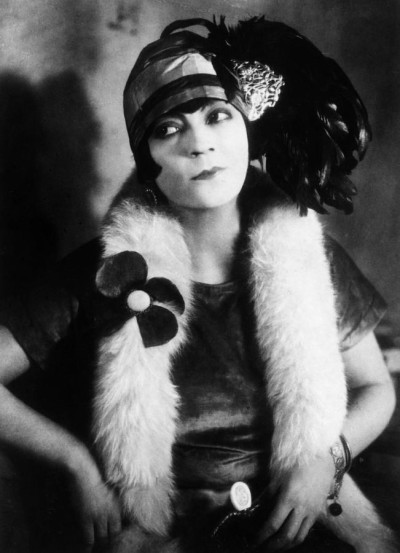Asta Nielsen (Asta Sofie Amalie Nielsen)

Asta Sofie Amalie Nielsen was born in the Vesterbro section of Copenhagen, Denmark, the daughter of an often unemployed blacksmith and a washerwoman. Nielsen’s family moved several times during her childhood while her father sought employment. They lived for several years in Malmö, Sweden where her father worked in a corn millery and then a factory. After he lost those jobs, they returned to live in the Nørrebro section of Copenhagen. Asta Nielsen’s father died when she was fourteen years old. At the age of eighteen, Nielsen was accepted into the acting school of the Royal Danish Theatre. During her time there, she studied closely with the Royal Danish Actor, Peter Jerndorff.[3] In 1901, twenty-year-old Nielsen became pregnant and gave birth to her daughter, Jesta. Nielsen never revealed the identity of the father, and chose to raise her child alone with the help of her mother and older sister. Nielsen graduated from the Theater school in 1902. For the next three years she worked at the Dagmar Theatre, then toured in Norway and Sweden from 1905 to 1907 with De Otte and the Peter Fjelstrup companies. Returning to Denmark, she was employed at Det Ny Theater from 1907 to 1910. Although she worked steadily as a stage actress, her performances remained unremarkable. Danish historian Robert Neiiendam wrote that Nielsen’s unique physical attraction, which was of great value on the screen, was limited on stage by her deep and uneven speaking voice.
Nielsen began her film career in 1909, starring in director Urban Gad’s 1910 tragedy Afgrunden (“The Abyss”). Nielsen’s minimalist acting style was evidenced in her successful portrayal of a naive young woman lured into a tragic life. Her overt sexuality in the film’s “gaucho dance” scene established the erotic quality for which Nielsen became known. Because of the film’s success, Nielsen continued to act in cinema rather than on stage. Nielsen and Gad married, then made four more films together. The explosion of Nielsen’s popularity propelled Gad and Nielsen to move from Denmark to Germany where she was provided her own film studio and the opportunity for greater profits. In Germany, Nielsen formed a contract with German producer Paul Davidson who founded the Internationale Film-Vertriebs-Gesellschaft in conjunction with Nielsen and Gad. The company held the European rights on all Nielsen films and Nielsen became a “scintillating international film star”, known simply as Die Asta (The Asta), with an annual fee of 85,000 Marks in 1914 alone. Nielsen contracted for $80,000 a year, then the highest salary for a film star. Nielsen is called the first international movie star, challenged only by French comic Max Linder, also famous throughout Europe and in America by that time. In a Russian popularity poll of 1911 Nielsen was voted the world’s top female movie star, behind Linder and ahead of her Danish compatriot Valdemar Psilander. She remained popular on both sides through World War I and in 1915 (before the United States’ entry into it) she visited New York City to study American film techniques.
In 1925 she starred in the German film Die freudlose Gasse (The Joyless Street or The Street of Sorrow), directed by G. W. Pabst and co-starring the next Scandinavian diva, Greta Garbo, months before Garbo left for Hollywood and MGM. She worked in German films until the start of sound movies. Nielsen made only one feature movie with sound, Unmögliche Liebe (Crown of Thorns) in 1932. However, the new technical developments in cinema were not suitable to Nielsen’s style, nor could her maturity compete with the young American ingenues, so retired from the screen. Thereafter, Nielsen acted only on stage. After the rise of Nazism she was offered her own studio by propaganda minister Joseph Goebbels. Nielsen later described being invited to tea with Adolf Hitler, who tried to convince her to return to film and explained the political power of her on-screen presence. Understanding the implications, Nielsen declined and left Germany in 1936. She returned home to Denmark where she wrote articles on art and politics and a two-volume autobiography. She is considered to be a great movie actress because of her natural performing style, adapting to the demands of the film media and avoiding theatrical dramatization. She was also adept at portraying women from varying social strata as well as of different psychologies. During the Second World War she provided money for Allan O. Hagedorff, a young Dane living in Germany, to assist Jews. Using money provided by Nielsen, Hagedorff sent so many food parcels to the Theresienstadt concentration camp that he was warned by the Gestapo. Among others, Victor Klemperer, the diarist and philologist, was offered money by Hagedorff. She was married three times. She died in 1972.
Born
- September, 11, 1881
- Vesterbro, Denmark
Died
- May, 24, 1972
- Frederiksberg, Denmark
Cemetery
- Vestre Kirkegard
- Copenhagen, Denmark



